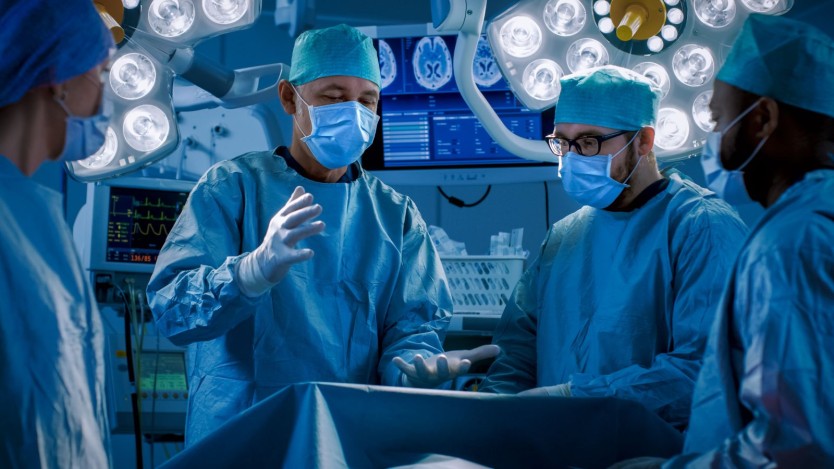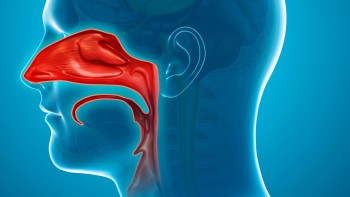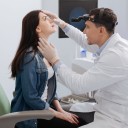Radiofrequency turbinate surgery: duration, cost and step by step

- What are turbinates?
- Causes of turbinate inflammation
- Diagnosis of turbinate inflammation
- Treatments for nasal turbinates inflammation
- Radiofrequency turbinate surgery: step-by-step
- Duration of radiofrequency turbinate surgery
- Cost of radiofrequency turbinate surgery
- Request a surgical assessment consultation for radiofrequency turbinate surgery
- The turbinates are internal structures of the respiratory system that are responsible for filtering, heating and humidifying the air we breathe. When turbinate hypertrophy occurs, all these functions are affected.
- There are different treatments for turbinate inflammation or hypertrophy. The appropriate treatment will be carried out depending on the cause and severity of the nasal abnormality.
- Radiofrequency turbinate surgery is the most commonly used technique to eliminate nasal obstruction caused by turbinate hypertrophy. This procedure is performed on an outpatient basis and is minimally invasive and painless.
What are turbinates?
The turbinates are a nasal sinus structure located inside the nose. This structure is responsible for humidifying the air we breathe, heating it so that it does not reach the lungs cold and thus improving the quality of breathing.
There are three turbinates on both sides of the nasal cavity, separated by the nasal septum.
They are staggered in position and, depending on their size, there are the upper, middle and lower turbinates, the latter being the one with the largest volume and, therefore, the one with the greatest risk of causing nasal obstruction.
When we talk about turbinate hypertrophy, we are referring to inflammation of the turbinates. This abnormality in the turbinates involves an exaggerated widening or enlargement of the nasosinusal structure.
The main function of this structure is to direct the flow of air through the nasal cavity and the inferior turbinates regulate this flow by congesting and decongesting the cavernous tissue, i.e. increasing and reducing its size.
Therefore, when the turbinates become inflamed or there is hypertrophy in the structure, nasal obstruction occurs, among many of its symptoms.

Do you need turbinates reduction surgery?
Request a free and immediate appointment with our specialists in Otorhinolaringology
There are some factors that increase the risk of inflammation of the turbinates, such as colds, allergies, tobacco and/or alcohol intake. All of these can alter the functioning of the turbinates and cause hypertrophy of the turbinates.
Symptoms of turbinate inflammation
Any disease that can be treated with medication runs the risk of not working. In the case of turbinate hypertrophy, if the intake of prescription drugs does not stop the inflammation, it can become chronic.
The symptoms of turbinate inflammation are diverse and can occur intermittently or persist over time, as we have already mentioned.
These symptoms can be asymptomatic or, on the contrary, very annoying, for example:
- Permanent nasal congestion
- Physical tiredness
- Apnoea and sleep disorders
- Difficulty breathing through the nose
- Hearing problems and discomfort
- Nosebleeds
- Loss of smell
- Facial pain
- Snoring
As we said earlier, the symptoms of inflammation or hypertrophy of the turbinates can occur periodically or not at all. However, lack of treatment can turn hypertrophy into a chronic pathology. Therefore, if you have any of these symptoms, Operarme recommends that you see a specialist to diagnose the main cause of the discomfort.

The most common causes of turbinate inflammation are allergic processes such as allergic rhinitis, among many others. Below you will find a list of the main causes of turbinate hypertrophy.
Causes of turbinate inflammation
Inflammation of the turbinates is a growth in the mucous membranes leading to chronic nasal congestion, with respect to its inflammation. This structural disorder is usually caused by allergic processes such as allergic rhinitis.
However, there are other factors that influence turbinate inflammation:
- Hormonal change. Certain medications, pregnancy or puberty can alter hormone production, contributing to nasal obstruction.
- Advanced age. The degradation of the organism and a series of underlying pathologies can favour the development of turbinate hypertrophy.
- Overweight. Obesity causes a decrease in lung volume and requires more effort to breathe.
- Being in inappropriate spaces. The airways work harder to breathe when exposed to toxic substances, leading to enlarged turbinates.
- Smoking and/or alcohol consumption. These two lifestyle habits affect the functioning of the structure until it collapses and causes nasal obstruction.
- Acute or chronic sinusitis. Inflammation and involvement of the sinuses can lead to turbinate hypertrophy.
- Deviated nasal septum. In this case, the work of breathing is more difficult, so that the turbinates make a greater effort and the turbinates are altered.
- Pharmacological treatment. Most steroid treatments or nasal application can cause inflammation of the nasal structure and lead to turbinate hypertrophy.
As we have mentioned in previous points, turbinate inflammation can have a series of symptoms, which can be asymptomatic or very bothersome.
In the event that you have any of them, Operarme advises you to visit your doctor so that he or she can make a more accurate diagnosis of the cause of the inflammation.
In this way, the need for radiofrequency turbinate reduction surgery can be checked more precisely. Therefore, we explain below what the techniques used to make the diagnosis consist of.
Diagnosis of turbinate inflammation
The ENT specialist is the one who will check the state of the turbinates to make a diagnosis. To examine the nasal cavities and check for possible inflammation or hypertrophy, this can be done in different ways, although the most common is rhinoscopy.
This technique is a minimally invasive manoeuvre that lasts approximately 5-10 minutes.

As you will already know, diagnosis by rhinoscopy is a determining factor in performing radiofrequency turbinate surgery.
In this test, the ENT specialist visualises the inside of the nostrils through the rhinoscope, an instrument that separates the nasal ala from the septum, increasing the field of vision, together with a front mirror and a light source.
The rhinoscopy will be of one type or another, depending on the technique used:
- Anterior rhinoscopy: with this technique, the nose is approached through the nose. The ENT specialist views the elements of the anterior portion of the nostrils, such as the mucosa, the nasal vestibule, the inferior turbinates and sometimes the middle turbinates, i.e. the roof of the nostrils and the choanae. During the test, you will be in an armchair, with your head straight, your mouth closed and breathing normally, calmly and through your nose.
- Posterior rhinoscopy: unlike the previous one, this test is performed through the mouth. The doctor visualises the posterior part of the nostrils, i.e. the upper turbinate, the middle turbinate, the tail of the lower turbinate and the vomer. Posterior rhinoscopy uses a speculum, a front mirror and an external light source. During the test, the patient is seated in the chair, with the head straight and slightly forward. When performing the examination through the mouth, the mouth is held open, with the tongue relaxed inside the mouth and, likewise, breathing calmly through the nose.
Treatments for nasal turbinates inflammation
Inflamed turbinates are a hypertrophy of this nasal structure. As we have already mentioned, the inferior turbinates are responsible for redirecting airflow through the nasal cavities. Therefore, when inflammation is excessive, the inferior turbinates cause nasal obstruction.
The main cause of turbinate hypertrophy or inflammation is usually an allergic process such as allergic rhinitis, but there are many other causes. Therefore, a diagnosis is necessary in order to develop an appropriate treatment for the specific treatment of each patient and situation.
There are different treatments for turbinate inflammation or hypertrophy. Therefore, as we said before, the diagnosis will determine the need for one or the other.
Preventive treatment
If your problem is related to allergic processes or substances that have irritated the area, preventive treatment may work for you. The treatment to be carried out in these cases will be determined by the cause that has provoked the allergy and the inflammation of the turbinates. Therefore, some safety measures will be taken to help prevent nasal obstruction, such as:
- Remove pollen from your home.
- Remove dust.
- If you have pets, keep them clean to avoid dandruff.
Pharmacological treatment
This treatment is based on the intake of drugs to reduce the inflammation of the turbinates. Depending on the type of medication, a distinction is made between corticosteroid nasal sprays and/or allergy medications.
In addition, in these cases it will help not to be exposed to environmental irritants. As with the safety measures of preventive treatment, all this will help to reduce swelling of the turbinates and thus improve nasal breathing.

When drug treatment does not provide an effective solution, other options for turbinate inflammation may be indicated. If drug treatment has not been effective, turbinate hypertrophy or inflammation may become chronic. In this case, the ENT specialist will recommend surgical treatment as the only effective solution.
Surgical treatments
As you know, there are different solutions to solve turbinate hypertrophy or inflammation. The decision to carry out one or the other will depend on the patient's diagnosis. Normally, the patient who undergoes surgical treatment does so because the other treatments have not solved the problem in the turbinates.
The aim of surgical treatment is to reduce or eliminate the part of the bone structure that has caused the nasal obstruction.
Among all the treatments of this type, we find:
- Turbinoplasty, or surgical fracture, modifies the position of the turbinates. The surgeon intervenes with endoscopic tools and accesses the interior of the nasal cavities until reaching the turbinates. This technique reduces the size of the turbinate by sectioning a small part of it.
- Turbinectomy. This surgical technique involves the total or partial removal of the turbinate, sectioning the tissue necessary to eliminate the nasal obstruction. In turbinectomy, as with turbinoplasty, endoscopic tools are used.
- Radiofrequency is the most common technique for reducing the size of the turbinates. It involves the use of electrodes that are inserted through the nostrils and placed on the turbinates. Electromagnetic energy circulates through the electrodes and increases the temperature of the tissues without damaging the adjacent structures in order to solve turbinate inflammation.
- The laser cauterises the nasal mucosa to reduce the size of the turbinates and reduce nasal obstruction.
The most commonly used surgical treatment to solve turbinate inflammation and eliminate nasal obstruction is turbinate surgery by radiofrequency. We will explain what this procedure consists of below.
In addition, we remind you that, in the event that you have a clear diagnosis that determines the need for surgery, you can request a free surgical assessment consultation. Operarme’s team will be at your disposal to manage your consultation and answer any questions you may have regarding turbinate surgery by radiofrequency. If you would like to make an appointment, you can do so by calling at +34 91 141 33 56, or by clicking on the following image and filling in the form with your details.

Do you need turbinates reduction surgery?
Request a free and immediate appointment with our specialists in Otorhinolaringology
Radiofrequency turbinate surgery: step-by-step
Radiofrequency turbinate reduction surgery is the most commonly used surgical procedure to eliminate nasal obstruction caused by inflammation in the turbinates.
Electromagnetic energy circulates through electrodes that are inserted through the nostrils and placed in the turbinates, increasing the temperature of the tissues without damaging the adjacent structures, in order to solve turbinate inflammation.
Radiofrequency treatment for turbinate reduction is a minimally invasive and painless procedure. In fact, the patient can leave the hospital the same day of the operation as it is done on an outpatient basis. To find out how the day of the operation will go, read on.

First of all, you will be given appropriate clothing to enter the operating theatre area so that you can be operated on properly.
After getting ready for surgery, you will be transferred to the operating theatre where you will meet the surgeon, the anaesthesiologist and a member of the nursing team. Once you are on the operating table, the radiofrequency turbinate surgery will begin:
- The first step will be to administer a local anaesthetic to numb the area.
- After the anaesthetic takes effect, the surgeon will insert the tip of a needle-tipped terminal through the nostrils and puncture the front of the inferior turbinate.
- This surgical instrument is connected to radiofrequency equipment that transmits energy to the turbinate tissue to reduce the volume of the turbinates. The ultimate goal of this is to create a space in the nostrils for airflow to enter.
- Once the optimal size of the turbinates is achieved, the surgeon will remove the instrument from the nasal cavity and you will be taken to the recovery room to remove all the anaesthesia.
Once you have recovered from the effects of the anaesthesia and the surgeon has checked that everything has gone perfectly, you can go home.
Recovery after radiofrequency turbinate surgery
It is normal for swelling and mucous to appear inside the nose after the operation. Even so, this is no cause for alarm as, as the days go by, all these post-operative symptoms will gradually disappear.
However, in order to promote recovery, it is advisable to follow the instructions of the doctor who has dealt with your case. Some of these measures may include:
- Nasal washings. It is important to keep the operated area clean. Therefore, one of the recommendations is to wash the nose with physiological saline solution or saline water to promote healing and prevent subsequent infections.
- Avoid heat. During the first few days after the operation, it is important to avoid exposure to heat, physical exercise or taking aspirin, which can contribute to the development of nosebleeds.
In a matter of 10-15 days after the operation, you will be fully recovered. Even so, the improvement will be progressive, so that, as the days go by, you will feel better until two weeks after the radiofrequency turbinate surgery, when you will finally feel no discomfort at all.
Duration of radiofrequency turbinate surgery
Radiofrequency turbinate reduction surgery is performed on an outpatient basis, so the patient can go home the same day of the operation, without the need for hospitalisation.
This surgery is performed under local anaesthesia and sedation.
However, days before the operation, you will have a consultation with the surgeon and the anaesthetist where you will be given a detailed explanation of what the radiofrequency consists of, the duration of the operation, the recovery stage, etc.
As you may already know, this technique is the most commonly used to eliminate nasal obstruction caused by inflammation or hypertrophy of the turbinates. One of its strong points is its short duration.
Radiofrequency turbinate surgery is a 10-20 minute procedure.
On the other hand, the recovery period will end 10-15 days after the operation. However, as we mentioned in the previous paragraph, you will notice improvement as the days go by.
Cost of radiofrequency turbinate surgery
Turbinate surgery restores the correct functioning of the nasal structure, functions that were affected by inflammation or hypertrophy of the turbinates.
The main symptoms may be nasal obstruction or rhinorrhoea, including headache or facial pain, difficulty breathing through the nose, sleep apnoea, pharyngitis, sinusitis and/or headache.
With the onset of turbinate hypertrophy, ENT specialists recommend the use of radiofrequency turbinate surgery to improve your quality of life and eliminate the respiratory limitations caused by the condition.
The cost of the radiofrequency turbinate reduction surgery at Operarme is 3.990 €, all-inclusive. Below you will find a breakdown of the services included in the radiofrequency turbinate surgery at Operarme:
- Booking and use of operating theatre
- Single room with a spare bed, meals and overnight accommodation for up to 1 day for the patient.
- Pre-operative tests (electrocardiogram, blood tests and chest x-ray, if the doctor deems it necessary).
- Medical fees.
- Anaesthesiologist fees.
- Surgical material necessary for the operation.
- Medical complications insurance. As you may already know, all Operarme surgeries include an insurance policy that covers additional expenses that may occur, such as the need to stay more days in hospital. This does not usually happen, but the company offers it as a means of prevention and security for the patient.
- Free transfer service. Operarme offers a transfer service for the patient on the day of admission and discharge from hospital. In this way, the patient does not have to worry about the transfer. In addition, our patient service team will be available to solve any questions or setbacks that may arise.
Request a surgical assessment consultation for radiofrequency turbinate surgery
If you have a clear case of turbinate hypertrophy or inflammation, you can request your free surgical assessment consultation through Operarme.
Remember that, as with every surgery, the company has a patient care service ready to answer any questions you may have, as well as to manage the first consultation and maintain follow-up contact during the preoperative and surgical stages, in the event that you finally contract the surgery.
If you would like to request your surgical assessment consultation with Operame you can do so by calling at +34 91 141 33 56, by filling in our contact form, or by clicking on the following image:

Do you need turbinates reduction surgery?
Request a free and immediate appointment with our specialists in Otorhinolaringology
Medical disclaimer: All the published content in Operarme is intended to disseminate reliable medical information to the general public, and is reviewed by healthcare professionals. In any case should this information be used to perform a diagnosis, indicate a treatment, or replace the medical assessment of a professional in a face to face consultation. Find more information in the links below:



